This week we follow Cinefest, the 17th International Festival of German Film-Heritage. The theme is 'Cinema, War, and Tulips: German-Dutch Film Relations'. EFSP co-host Ivo Blom is one of the guest-curators of the festival and congress. Because of Corona, Cinefest will be only online and in a limited form this year. The film programme will consist of 9 Dutch films of the 1930s made by emigré directors including Detlev Sierck (a.k.a. Douglas Sirk), Max Ophüls and Ludwig Berger. So till the end of the Cinefest on 22 November 2020, EFSP will post daily on stars, directors, and films connected to the festival theme. Today, we start with Ivo's personal postcard choice.
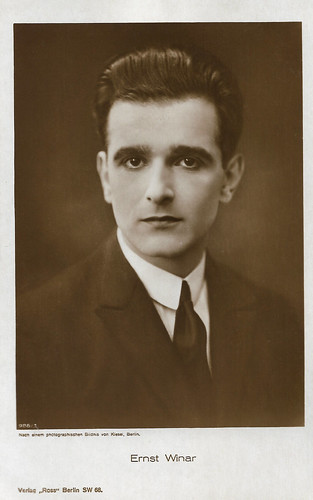
German postcard, no. 988/1, 1925-1926. Photo: Kiesel, Berlin.
Dutch actor Ernst Winar (1894-1978) appeared in 34 films between 1916 and 1955, in The Netherlands and as well in Germany. He got his first major role in Germany in Die Benefizvorstellung der Vier Teufel/The benefit performance of the four devils (1920) by Danish director Anders Wilhelm Sandberg. The film was a success and numerous films followed. He was also a film director and made 14 films between 1922 and 1955. First, he was responsible for three episodes of the Terra series Flappy with Adolphe Engers in the lead role. In 1922, he directed his first feature film, the crime film Der Mann im Hintergrund/The man in the background, but the film was released only after several changes in October 1924. In 1932 Winar returned to the Netherlands. He made the short sound film Hollandsch Hollywood (1933) for which revue star Fien de la Mar sang the title song, announcing a new Dutch film industry. In 1935 Winar and Fien de la Mar worked together again on the musical Op Stap (Ernst Winar, 1935) which also featured revue stars Louis and Heintje Davids and Adolphe Engers, who was also back from Berlin. In the early 1960s, he edited the first short films of Paul Verhoeven.

German postcard by Ross Verlag, no. 3186/1, 1928-1929.
Impressive Dutch actor Adolphe Engers (1884-1945) appeared in some 50 German and Dutch films in the 1920s and 1930s. In the 1920s he became a very busy actor in Germany, often playing with fellow compatriote actors like Ernst Winar. Already in his second German film, Der Liebeskorridor/The Love Passage (Emil Albes, 1920), Engers had the male lead of the film, opposite Erika Glässner. Engers played in Ernst Winar's German-Dutch coproduction De man op den achtergrond/Der Mann im Hintergrund (The Man in the Back, 1922). He was also highly succesful with his leading role in the Flappy serial, three short films directed by Winar for the Berliner Terra Film AG. Engers also acted in films by other Dutch filmmakers residing in Berlin like Theo Frenkel and Jaap Speyer.

Dutch postcard by B. Brouwer, Amsterdam. Photo: Bernard Eilers, Amsterdam.
Little Henkie Klein (1921-ca. 1993) was a child actor in German and Dutch films of the silent era. He was called the 'Dutch Jackie Coogan'. He was the son of film director Henk Kleinman(n). Henkie appeared in his father's film Die Fahrt ins Verderben/Op hoop van zegen (Henk Kleinman, James Bauer, 1924). This was the second film version of 'Op hoop van zegen' (On hope of blessing), a classic Dutch fisher drama written by Herman Heijermans in 1900. The success of the production lead to another film based on a play by Heijermans, Die vom Schicksal Verfolgten/Droomkoninkje/Little Dream King (Henk Kleinman, 1926) with Wilhelm Dieterle (aka William Dieterle) and Aud Egede Nissen. Little Henkie played the lead of a boy born with a clubfoot who creates his own dream world.
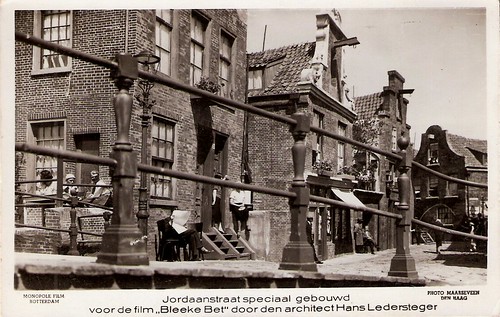
Dutch postcard by Monopole Film, Rotterdam. Photo: Dick van Maarseveen.
Still of a set built for Bleeke Bet (Alex Benno, Richard Oswald, 1934), a street in the old neighbourhood De Jordaan in Amsterdam. The set designer was Hans Ledersteger.

Dutch postcard by M. B.& Z. (M. Bonnist & Zonen, Amsterdam) for Hollandia Film Prod. / Loet C. Barnstijn. Photo: Johan Kaart jr., Willy Castello and Jan van Ees in De Jantjes/The Tars (Jaap Speyer, 1934).
The musical drama De Jantjes (Jaap Speyer, 1934) is a little pre-war Dutch gem. It was the second Dutch sound film and a huge box office hit at the time. De Jantjes (the international title is The Tars) was based on a popular Jordaan play (a play set in an old neighbourhood of Amsterdam, the Jordaan) by Herman Bouber, which was already filmed in 1922.

Dutch postcard by Hollandia Film Prod. / Loet C. Barnstijn. Photo: Joan Remmelts, Jan van Ees, Sylvain Poons, Johan Kaart jr., Henriëtte Davids, Willy Castello, Susie Klein in De Jantjes (Jaap Speyer, 1934).
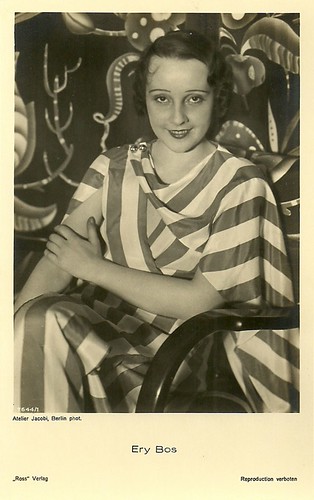
German postcard by Ross Verlag, no. 7644/1, 1932-1933. Photo: Atelier Jacobi.
The Dutch-German actress Ery Bos (1910-2005) had a short but productive film career in the early German sound film. In only three years, from 1932 to 1934 she took part in a dozen films.

Dutch postcard by M. B.& Z. (M. Bonnist & Zonen, Amsterdam). Photo: Filma. Truus van Aalten and Roland Varno in Het meisje met de blauwe hoed/The Girl with the Blue Hat (Rudolf Meinert, 1934).
Dutch-born actor Roland Varno (1908-1996) is best known for his role as one of the schoolboys in Der blaue Engel/The Blue Angel (Josef von Sternberg, 1930). He appeared in more German and Dutch films of the early 1930s and he also worked in Hollywood as a character actor, mainly in B-pictures.
Dutch film star Truus van Aalten (1910-1999) made 29 films in the 1920s and 1930s, and only one of them in the Netherlands, Het meisje met de blauwe hoed/The Girl with the Blue Hat (Rudolf Meinert, 1934).
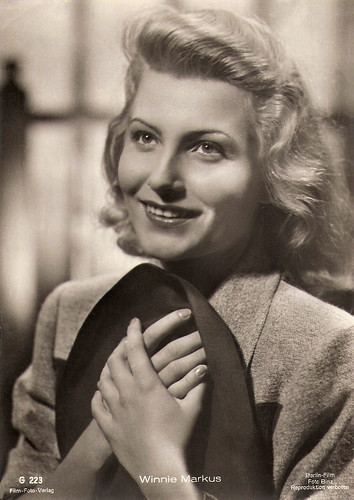
German postcard by Film-Foto-Verlag, no. G 223, 1941-1944. Photo: Berlin-Film / Foto Binz.
Blonde Winnie Markus (1921-2002) started as a Ufa star during the Nazi period and became in the 1950s one of Germany’s most famous actresses.

German postcard by Film-Foto-Verlag, no. G 151, 1941-1944. Photo: Wesel / Berlin-Film.
German singer and actress Magda Schneider (1909-1996) is best known as the mother of film star Romy Schneider, but in the 1930s, 1940s, and 1950s, she herself starred in some 40 films. First, she appeared on the screen as a charming Wiener mädel (Viennese girl) and after the war, she often played the understanding mother or aunt.
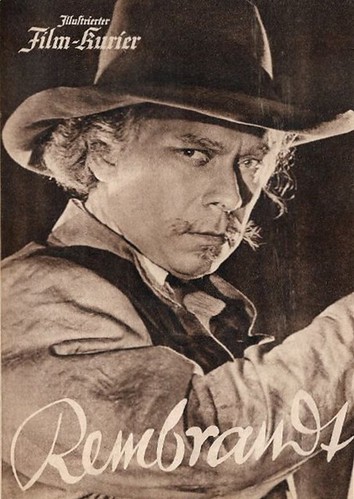
Cover of the special issue of Illustrierter Film-Kurier on the German biopic Rembrandt/ Ewiger Rembrandt (Hans Steinhoff, 1942), with Ewald Balser in the title role.
Rembrandt/ Ewiger Rembrandt (Hans Steinhoff, 1942) was shot both at the Dutch film studio Cinetone and the near The Hague based Filmstad studio, during the German Occupation of the Netherlands in World War Two. It was the first German film production in Holland during WWII, made between 1941 and 1942. Afterward several would follow, mainly by the newly founded company Berlin-Film. While the cast was fully German, some crew members were Dutch such as assistant-director Charles Huguenot van der Linden. Leading in the cast were Ewald Balser (Rembrandt), Herta Feiler (Saskia), Elisabeth Flickenschildt (Geertje), Gisela Uhlen (Hendrikje), Theodor Loos (Jan Six), Aribert Wäscher (Uijlenburgh), and Paul Henckels (etcher Seeghers). Small parts were for well-known routinés such as Eduard von Winterstein, Frida Richard, Nicolas Koline, Angelo Ferrari, and Viktor Janson, according to IMDb. Sets were by Walter Röhrig, famous for his art direction of the Expressionist cinema.
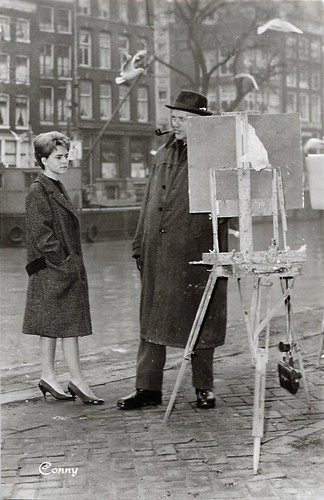
Dutch postcard by Ed. Int. Filmpers, Amsterdam.
Conny Froboess visited the Netherlands a few times, probably first in May 1959 when she visited Amsterdam to promote her new film Teenager-Melodie/Wenn die Conny mit dem Peter (Fritz Umgelter, 1958). She returned in February 1960 for a performance at the Scheveningen Kurhaus during a dance contest, and in September 1962 for the Grand Gala du Disque.

German postcard. Photo: Omega Film. Autographed postcard of Alexander Kerst in Ciske - Ein Kind Braucht Liebe (Wolfgang Staudte, 1955), based on the novel by Dutch author Piet Bakker.
This was the German version of the parallel made Dutch film Ciske, de rat (Wolfgang Staudte, 1955), situated and shot in the city of Amsterdam (with interiors shot at the Amsterdam Cinetone film studio). Kerst played the sailor Freymuth, Ciske's father. Part of the Dutch cast played in the German version as well, including Kees Brusse as Ciske's teacher Bruis, and young Dick van der Velde as Ciske himself. While the Dutch version became the third-best viewed Dutch film in the Netherlands and won a Silver Lion in Venice, the German version was not a huge success in Germany and remained one of the most unknown films of Staudte.

Dutch postcard by Uitg. Takken, Utrecht, no. 3192. Photo: N.V. Standaardfilms. Ellen van Hemert in Jenny (Willy van Hemert, 1958).
Ellen van Hemert (1937) starred in the Dutch romcom Jenny (1958). Jenny was the first Dutch film in colour. The film was directed by Ellen's father Willy van Hemert, a television director who made only one theatrical feature. The producer was NV Standaardfilms. Furthermore, Ellen van Hemert made only a few television films in the early sixties. She is the sister of film director Ruud van Hemert and she was married to actor Coen Flink.

East-German postcard by VEB Progress Film-Vertrieb, Berlin, no. 2010, 1964. Retail price: 0,20 DM. Photo: publicity still for De Overval/The Silent Raid (Paul Rotha, 1962).
Dutch actor Rob de Vries (1918–1969) was the star of the classic war film De Overval/The Silent Raid (1962). During the 1940s and 1950s, he appeared in more Dutch films that were internationally successful.

German postcard by VEB Progress Film-Vertrieb, Berlin, no. 54/68. Photo: Wenze DEFA. Lore Frisch in Zar und Zimmermann/Tsar and Carpenter (Hans Müller, 1956), adapted from the comical opera by Albert Lortzing.
Lore Frisch (1925-1962) was a German film actress of the 1950s and early 1960s, who in the 1950s starred in the popular DEFA films Der Ochse von Kulm (1955), Zar und Zimmermann (1956), and Meine Frau macht Musik (1958). When her married lover abandoned her, she committed suicide.
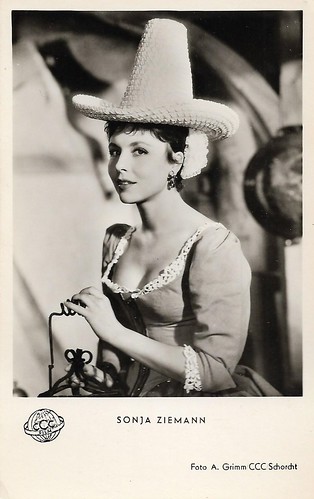
German postcard. Photo: Arthur Grimm / CCC Film (Artur Brauner) / Schorcht. Sonja Ziemann in Das Bad auf der Tenne (Paul Martin, 1956).
On 17 February 2020, German film and television actress, singer, and dancer Sonja Ziemann (1926) passed away at the age of 94. The delicately lovely, dark-haired, and innocent-looking Ziemann was one of the first stars of Germany's post-war cinema. She starred in film operettas and Heimatfilms as Schwarzwaldmädel/The Black Forest Girl (1950) and Grün ist die Heide/The Heath is Green (1951). Her private life knew several tragedies.

German postcard. Photo: CCC (Central Cinema Company Film). Sonja Ziemann in Hollandmädel/Dutch Girls (J.A. Hübler-Kahla, 1953).

German postcard, no. 988/1, 1925-1926. Photo: Kiesel, Berlin.
Dutch actor Ernst Winar (1894-1978) appeared in 34 films between 1916 and 1955, in The Netherlands and as well in Germany. He got his first major role in Germany in Die Benefizvorstellung der Vier Teufel/The benefit performance of the four devils (1920) by Danish director Anders Wilhelm Sandberg. The film was a success and numerous films followed. He was also a film director and made 14 films between 1922 and 1955. First, he was responsible for three episodes of the Terra series Flappy with Adolphe Engers in the lead role. In 1922, he directed his first feature film, the crime film Der Mann im Hintergrund/The man in the background, but the film was released only after several changes in October 1924. In 1932 Winar returned to the Netherlands. He made the short sound film Hollandsch Hollywood (1933) for which revue star Fien de la Mar sang the title song, announcing a new Dutch film industry. In 1935 Winar and Fien de la Mar worked together again on the musical Op Stap (Ernst Winar, 1935) which also featured revue stars Louis and Heintje Davids and Adolphe Engers, who was also back from Berlin. In the early 1960s, he edited the first short films of Paul Verhoeven.

German postcard by Ross Verlag, no. 3186/1, 1928-1929.
Impressive Dutch actor Adolphe Engers (1884-1945) appeared in some 50 German and Dutch films in the 1920s and 1930s. In the 1920s he became a very busy actor in Germany, often playing with fellow compatriote actors like Ernst Winar. Already in his second German film, Der Liebeskorridor/The Love Passage (Emil Albes, 1920), Engers had the male lead of the film, opposite Erika Glässner. Engers played in Ernst Winar's German-Dutch coproduction De man op den achtergrond/Der Mann im Hintergrund (The Man in the Back, 1922). He was also highly succesful with his leading role in the Flappy serial, three short films directed by Winar for the Berliner Terra Film AG. Engers also acted in films by other Dutch filmmakers residing in Berlin like Theo Frenkel and Jaap Speyer.

Dutch postcard by B. Brouwer, Amsterdam. Photo: Bernard Eilers, Amsterdam.
Little Henkie Klein (1921-ca. 1993) was a child actor in German and Dutch films of the silent era. He was called the 'Dutch Jackie Coogan'. He was the son of film director Henk Kleinman(n). Henkie appeared in his father's film Die Fahrt ins Verderben/Op hoop van zegen (Henk Kleinman, James Bauer, 1924). This was the second film version of 'Op hoop van zegen' (On hope of blessing), a classic Dutch fisher drama written by Herman Heijermans in 1900. The success of the production lead to another film based on a play by Heijermans, Die vom Schicksal Verfolgten/Droomkoninkje/Little Dream King (Henk Kleinman, 1926) with Wilhelm Dieterle (aka William Dieterle) and Aud Egede Nissen. Little Henkie played the lead of a boy born with a clubfoot who creates his own dream world.

Dutch postcard by Monopole Film, Rotterdam. Photo: Dick van Maarseveen.
Still of a set built for Bleeke Bet (Alex Benno, Richard Oswald, 1934), a street in the old neighbourhood De Jordaan in Amsterdam. The set designer was Hans Ledersteger.

Dutch postcard by M. B.& Z. (M. Bonnist & Zonen, Amsterdam) for Hollandia Film Prod. / Loet C. Barnstijn. Photo: Johan Kaart jr., Willy Castello and Jan van Ees in De Jantjes/The Tars (Jaap Speyer, 1934).
The musical drama De Jantjes (Jaap Speyer, 1934) is a little pre-war Dutch gem. It was the second Dutch sound film and a huge box office hit at the time. De Jantjes (the international title is The Tars) was based on a popular Jordaan play (a play set in an old neighbourhood of Amsterdam, the Jordaan) by Herman Bouber, which was already filmed in 1922.

Dutch postcard by Hollandia Film Prod. / Loet C. Barnstijn. Photo: Joan Remmelts, Jan van Ees, Sylvain Poons, Johan Kaart jr., Henriëtte Davids, Willy Castello, Susie Klein in De Jantjes (Jaap Speyer, 1934).

German postcard by Ross Verlag, no. 7644/1, 1932-1933. Photo: Atelier Jacobi.
The Dutch-German actress Ery Bos (1910-2005) had a short but productive film career in the early German sound film. In only three years, from 1932 to 1934 she took part in a dozen films.

Dutch postcard by M. B.& Z. (M. Bonnist & Zonen, Amsterdam). Photo: Filma. Truus van Aalten and Roland Varno in Het meisje met de blauwe hoed/The Girl with the Blue Hat (Rudolf Meinert, 1934).
Dutch-born actor Roland Varno (1908-1996) is best known for his role as one of the schoolboys in Der blaue Engel/The Blue Angel (Josef von Sternberg, 1930). He appeared in more German and Dutch films of the early 1930s and he also worked in Hollywood as a character actor, mainly in B-pictures.
Dutch film star Truus van Aalten (1910-1999) made 29 films in the 1920s and 1930s, and only one of them in the Netherlands, Het meisje met de blauwe hoed/The Girl with the Blue Hat (Rudolf Meinert, 1934).

German postcard by Film-Foto-Verlag, no. G 223, 1941-1944. Photo: Berlin-Film / Foto Binz.
Blonde Winnie Markus (1921-2002) started as a Ufa star during the Nazi period and became in the 1950s one of Germany’s most famous actresses.

German postcard by Film-Foto-Verlag, no. G 151, 1941-1944. Photo: Wesel / Berlin-Film.
German singer and actress Magda Schneider (1909-1996) is best known as the mother of film star Romy Schneider, but in the 1930s, 1940s, and 1950s, she herself starred in some 40 films. First, she appeared on the screen as a charming Wiener mädel (Viennese girl) and after the war, she often played the understanding mother or aunt.

Cover of the special issue of Illustrierter Film-Kurier on the German biopic Rembrandt/ Ewiger Rembrandt (Hans Steinhoff, 1942), with Ewald Balser in the title role.
Rembrandt/ Ewiger Rembrandt (Hans Steinhoff, 1942) was shot both at the Dutch film studio Cinetone and the near The Hague based Filmstad studio, during the German Occupation of the Netherlands in World War Two. It was the first German film production in Holland during WWII, made between 1941 and 1942. Afterward several would follow, mainly by the newly founded company Berlin-Film. While the cast was fully German, some crew members were Dutch such as assistant-director Charles Huguenot van der Linden. Leading in the cast were Ewald Balser (Rembrandt), Herta Feiler (Saskia), Elisabeth Flickenschildt (Geertje), Gisela Uhlen (Hendrikje), Theodor Loos (Jan Six), Aribert Wäscher (Uijlenburgh), and Paul Henckels (etcher Seeghers). Small parts were for well-known routinés such as Eduard von Winterstein, Frida Richard, Nicolas Koline, Angelo Ferrari, and Viktor Janson, according to IMDb. Sets were by Walter Röhrig, famous for his art direction of the Expressionist cinema.

Dutch postcard by Ed. Int. Filmpers, Amsterdam.
Conny Froboess visited the Netherlands a few times, probably first in May 1959 when she visited Amsterdam to promote her new film Teenager-Melodie/Wenn die Conny mit dem Peter (Fritz Umgelter, 1958). She returned in February 1960 for a performance at the Scheveningen Kurhaus during a dance contest, and in September 1962 for the Grand Gala du Disque.

German postcard. Photo: Omega Film. Autographed postcard of Alexander Kerst in Ciske - Ein Kind Braucht Liebe (Wolfgang Staudte, 1955), based on the novel by Dutch author Piet Bakker.
This was the German version of the parallel made Dutch film Ciske, de rat (Wolfgang Staudte, 1955), situated and shot in the city of Amsterdam (with interiors shot at the Amsterdam Cinetone film studio). Kerst played the sailor Freymuth, Ciske's father. Part of the Dutch cast played in the German version as well, including Kees Brusse as Ciske's teacher Bruis, and young Dick van der Velde as Ciske himself. While the Dutch version became the third-best viewed Dutch film in the Netherlands and won a Silver Lion in Venice, the German version was not a huge success in Germany and remained one of the most unknown films of Staudte.

Dutch postcard by Uitg. Takken, Utrecht, no. 3192. Photo: N.V. Standaardfilms. Ellen van Hemert in Jenny (Willy van Hemert, 1958).
Ellen van Hemert (1937) starred in the Dutch romcom Jenny (1958). Jenny was the first Dutch film in colour. The film was directed by Ellen's father Willy van Hemert, a television director who made only one theatrical feature. The producer was NV Standaardfilms. Furthermore, Ellen van Hemert made only a few television films in the early sixties. She is the sister of film director Ruud van Hemert and she was married to actor Coen Flink.

East-German postcard by VEB Progress Film-Vertrieb, Berlin, no. 2010, 1964. Retail price: 0,20 DM. Photo: publicity still for De Overval/The Silent Raid (Paul Rotha, 1962).
Dutch actor Rob de Vries (1918–1969) was the star of the classic war film De Overval/The Silent Raid (1962). During the 1940s and 1950s, he appeared in more Dutch films that were internationally successful.

German postcard by VEB Progress Film-Vertrieb, Berlin, no. 54/68. Photo: Wenze DEFA. Lore Frisch in Zar und Zimmermann/Tsar and Carpenter (Hans Müller, 1956), adapted from the comical opera by Albert Lortzing.
Lore Frisch (1925-1962) was a German film actress of the 1950s and early 1960s, who in the 1950s starred in the popular DEFA films Der Ochse von Kulm (1955), Zar und Zimmermann (1956), and Meine Frau macht Musik (1958). When her married lover abandoned her, she committed suicide.

German postcard. Photo: Arthur Grimm / CCC Film (Artur Brauner) / Schorcht. Sonja Ziemann in Das Bad auf der Tenne (Paul Martin, 1956).
On 17 February 2020, German film and television actress, singer, and dancer Sonja Ziemann (1926) passed away at the age of 94. The delicately lovely, dark-haired, and innocent-looking Ziemann was one of the first stars of Germany's post-war cinema. She starred in film operettas and Heimatfilms as Schwarzwaldmädel/The Black Forest Girl (1950) and Grün ist die Heide/The Heath is Green (1951). Her private life knew several tragedies.

German postcard. Photo: CCC (Central Cinema Company Film). Sonja Ziemann in Hollandmädel/Dutch Girls (J.A. Hübler-Kahla, 1953).
No comments:
Post a Comment